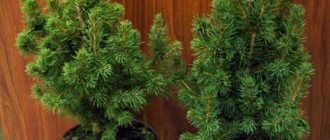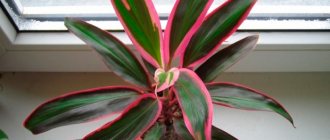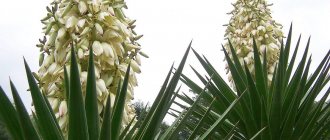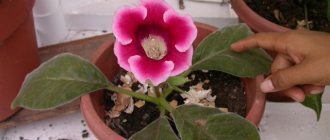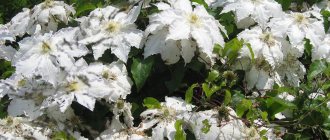Myrtle is extremely beautiful and, judging by the photo, can successfully adapt to life indoors. Various signs and superstitions, as well as mythological stories, are associated with myrtle..
So, it was a sprig of myrtle that Adam took from the Garden of Eden in memory of him. In Greek mythology, there is a legend about the appearance of an unfading plant, and it is associated with the tragic death of the daring nymph Myrsina, who dared to defeat Pallas Athena herself in the competition.
Today, myrtle is a houseplant that both experienced and novice gardeners enjoy caring for.
Varieties of myrtle with photos and names
There are more than 100 varieties of myrtle; only a few varieties are suitable for indoor cultivation. We list the most popular varieties.
Compacta
A medium-sized variety with dense, glossy, pointed foliage and a pleasant, characteristic aroma. It blooms with small terry corollas.
Tarentina
In the wild it grows up to 5 meters; when grown indoors in favorable conditions it can reach a height of a meter, but rarely. It is characterized by rapid growth and has small (only 1.5 cm) bright green foliage. Blooms profusely.

Boetica
The slow-growing variety is more suitable for creating bonsai than others: the trunk of this myrtle is very flexible. The foliage is quite large (about 7 cm), a beautiful rich green color.
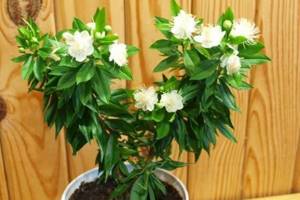
Variegata
It is distinguished by the variegated color of the leaves - they seem to be strewn along the edges with amber dots and stripes. To prevent the leaves from losing their color intensity, the bush requires a lot of ultraviolet light. In a favorable environment it blooms with small white flowers.

Alhambra
Although the alhambra is a subspecies of the common myrtle and is in many ways similar to it, it is not difficult to distinguish them: for example, the alhambra trunk has a curved shape, and the leaf plates are much larger.
An excellent ornamental plant with a pleasant aroma and characteristic fruits of a creamy-green hue. The flower, shaped like a star, has a delicate, pleasant aroma.
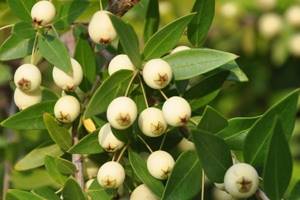
Flore pleno
Variation of the common myrtle. The main difference is the large fluffy sepals of the flowers.
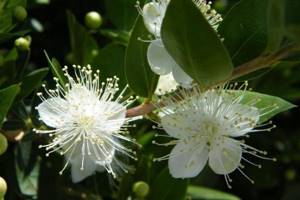
Common myrtle
A beautiful plant, when grown indoors it stops growing at 1.5 m, although in nature it easily grows up to 4 m. It is distinguished by leathery, bright, pointed foliage about 5 cm in length, small white flowers and a very pleasant aroma.

Chilean myrtle (Luma apiculata)
Another name was Eugenia acuminate or Luma acuminate. In the natural conditions of its homeland (South America), this variety of myrtle reaches gigantic sizes - up to 25 meters in height and about 10 meters in girth, but there are also plants with more modest data.
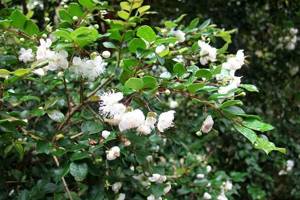
Most often used for landscaping adjacent areas.
Interesting! Chilean myrtle is long-lived - plants whose age reaches 600 years have been discovered.
Glanleam gold
A variety of Chilean myrtle with a beautiful variegated crown.

Myrtle communis
A distinctive feature of this compact bush is its unpretentiousness. It is suitable even for a beginning gardener.
It can form many shoots from the main stem, making this variety of myrtle look like a small tree. Blooms with single white flowers.
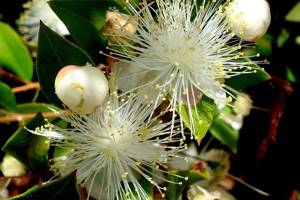
Citric
Known in Europe since the beginning of the twentieth century, where it was brought from Australia. This wild shrub has a subtle, lemon-like aroma, which is why it got its name.
A very rare product is produced from its pollen - myrtle honey. It is practically not used in indoor floriculture, since it can grow into a fairly large shrub.

Bolotny
Otherwise known as Kassanra, it grows as a meter-tall shrub. The leaf blades are large, up to 4 cm in length, elongated, with a sharp tip.
The flowers are arranged in clusters and are pale pink or cream in color. Not used as a house plant.
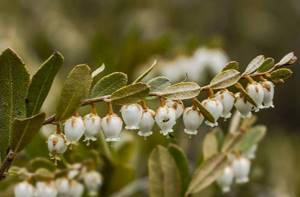
small-leaved
Depending on the form of pruning, it can grow into a tree or shrub. It is distinguished by small elongated bright green leaves and corollas with large stamens, under which the calyx of the flower itself is located.
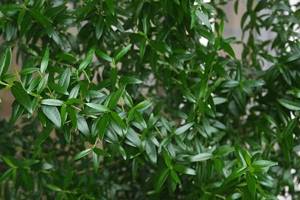
large-leaved
It can reach four meters in height, the leaves are 5 cm long. It bears fruit with large, centimeter-long blue berries. They are edible, but not very pleasant to the taste.
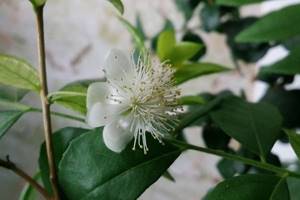
Interesting! Myrtle has a real double! It is mistakenly called African myrtle. With some external similarities, this plant belongs to the Myrsinov family, and it is correct to call it African myrsina.
Myrtle flower. Description, features, types and care of myrtle
Paradise flower. This is what they say about many beautiful plants. But the legends say that only myrtle . Adam took his branch with him as a reminder of God’s lands.
Expelled from Paradise, he planted myrtle. The flower has since become a sign of hope. The myrtle plant has become a symbol of peace. This interpretation is associated with the appearance of Zechariah and the angel. The plot is taken from the Bible.

To announce the restoration of the kingdom of Israel, the saints came in a myrtle bush. Its branch, according to scripture, was carried in its beak by a dove after the Great Flood. In general, the flower is covered in legends. What is myrtle like in reality?
Description and features of myrtle
The flower belongs to the Myrtaceae family. It includes angiosperms. common myrtle is accompanied by, for example, Guava and Clove tree. This plant is also a tree.
It is evergreen and low growing. The height of myrtle is closer to the bush, equal to 60-70 centimeters. The branches are dotted with small leaves. They are planted in pairs opposite each other and are distinguished by their rich green color and glossy shine.
Myrtle leaves are not only beautiful, but also fragrant. The esters released by the tree contain phytoncides. They are biologically active and suppress pathogenic microorganisms. Therefore, home and wild myrtle disinfect the air.
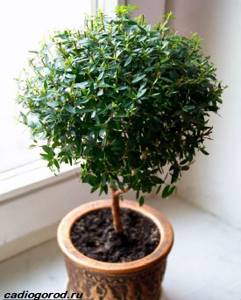
In the photo there is indoor myrtle
In ancient times, the phenomenon could only be explained by the divine origin of the plant. Hence, as historians believe, the legends about Myrtle’s stay in Paradise. This offends believers.
But no matter how you look at Myrtle, it is useful and smells nice. The aroma is rich. It is feared, for example, by the pathogens of diphtheria, staphylococci, streptococci and tuberculosis.
Myrtle, at home and in open ground, is capable of clearing 100 cubic meters and one and a half square meters of tree greenery around itself. This is the area of foliage.
is also blooming profusely . In the photo, the plant appears with buds reminiscent of apple trees. However, voluminous tufts of stamens emerge from the center of the white cinquefoils. They give the buds fluffiness.
Myrtle flowers became an integral attribute of wedding wreaths back in Ancient Greece. Among modern brides, Germans keep the tradition. In Greece, only a legend remained about the origin of the name Myrta. The propagation of the plant began after the death of Myrsina.
That was the name of one of the nymphs of Athena. The goddess of war was known as a swift runner. However, at one of the competitions, Mirsina beat the lady in the sprint.
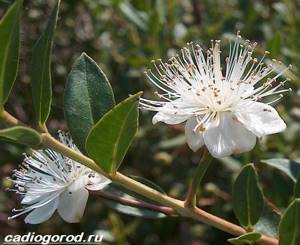
In the photo there is a flowering of myrtle
In anger, Athena killed the nymph, but, repenting, she begged the Gods to leave her at least some reminder of the girl. “Colleagues” took pity on Athena, turning Myrsina’s body into an elegant tree.
Outside of legends, Myrtle does not appear in one second, but grows over the years. The tree is a slow growing flower. Over the course of a year, the growth is no more than 15 centimeters. Usually it is 10 centimeters.
Accordingly, an adult tree is formed only 6-7 years after planting. By the way, in the Mediterranean region, the hero of the article reaches 2-5 meters in height, reaching for 20-30 years.
The gigantism of the Mediterranean Myrtle is associated with comfortable conditions for it. In Russia, indoor and garden myrtle feels the alienness of the environment and develops worse. However, while losing size, the plant from the Mediterranean does not lose its beauty.
Planting and propagation of myrtle
Myrtle overwinters in open ground only in regions where the winter temperature does not drop below -8 degrees. If the thermometer creeps lower, the plant will die.
Therefore, most Russians choose Myrtle as an indoor flower. It is propagated by seeds or cuttings. The latter are taken from the parent plant from January to February, or in the summer.
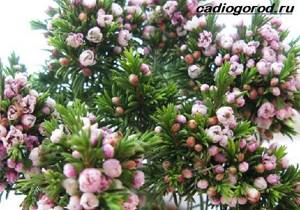
In the photo there is wax myrtle
In warm weather, green cuttings are used. They are young, flexible, but more vulnerable to rot. Winter branches are woody. Such cuttings are more durable, but require storage until spring in a dark, cool room. It is customary to place the cuts in slightly moist soil.
Branches about 7 centimeters long are suitable for Myrtle cuttings. You can also navigate by leaves. There should be 2-3 pairs of them on the cuttings. The lower ones are removed. Other leaves are cut approximately in half.
This is necessary to save Myrtle's energy for growth. If the leaves remain on the cuttings, instead of rooting, the branches will begin to send resources to maintain their tone.
Planting Myrtle cuttings involves keeping them in a growth stimulator. The preparations are sold in flower shops and gardening stores. The cuttings are lowered into the stimulator by about a centimeter, holding for 2 hours.
Afterwards, the sections of the branches are washed with running water and stuck 2-3 centimeters into the ground. It is made up of river sand, peat and vermiculite. They are taken in equal shares.
The planted Myrtle cuttings are covered with film and placed in a well-lit place, but without direct rays. They can burn plants. The temperature also needs to be average, about 20 degrees. Regular ventilation will be required.
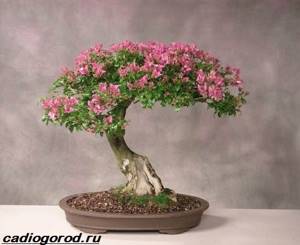
On the day, the pots are opened for 30-50 minutes. At this time, the cuttings are watered. It is enough to spray the soil generously with a spray bottle. Shoots will appear in 2-4 weeks. After waiting for 2 full leaves, the seedlings are transplanted into pots about 7 centimeters deep. Myrtle is transferred to open ground with 8-10 leaves.
Myrtle propagation by seeds begins at the end of February. The sowing deadline is the end of May. If you have fluorescent lamps, you can sow all year round, providing the sprouts with illumination.
Before planting, Myrtle seeds are washed in a weak solution of potassium permanganate. It disinfects grains. Afterwards, they need to be dried and planted in the same substrate as the cuttings. Deepen the seeds by 0.5 centimeters.
The depth of the pot should be about 7-10 centimeters. Further, the scheme coincides with the rooting of cuttings. You need to cover the plantings with film or glass, place them in a bright, warm place and wait. Shoots will appear in 1-2 weeks.
At the stage of two leaves, the seedlings dive. By pinching off the tip of the root, gardeners stimulate its branching. With a powerful root system, a tree takes root faster in open ground, resists diseases better, and blooms more profusely because it takes more nutrients from the soil.
Caring for myrtle
Mature Myrtle tolerates a small amount of direct rays of the Sun. Accordingly, place the plant on the western and eastern windows. The tree is moved to the south in winter. In summer, from the south, the bush is covered from the sun with tulle.
Northern windows require lighting. Without it, the tree will be spectacular, but will refuse to bloom. By the way, the buds on Myrtle bloom from mid-summer to mid-autumn.
Reviews of Myrtle speak of his love for fresh air. But the heat-loving plant does not tolerate drafts. Therefore, the tree is taken out into the fresh air in the summer. To harden the bush, you can bury the pot with it in open ground.
Its coolness will strengthen the health of the plant, and the warmth from above will give comfort. By the way, Myrtle likes relative coolness. Comfortable temperature – 18-20 degrees. It's summer. In winter, the tree needs coolness no higher than 10 degrees.
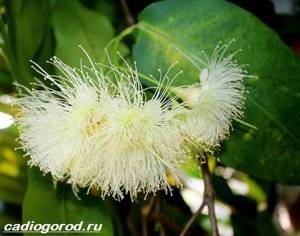
This makes growing Myrtle indoors problematic. In most Russian cities, the heating season “brings” 20-25 degrees to homes. We have to take the hero of the article out into glassed loggias and onto cool verandas. Otherwise, Myrtle sheds its foliage, losing its decorative value.
During the period of active growth, that is, from spring to autumn, the hero of the article is watered abundantly. They focus on drying out the top layer of soil. Use settled water. It should be soft. Hard is a liquid saturated with magnesium, calcium and iron salts. If they are present in tap water, filters are required.
In winter, Myrtle is watered sparingly. If serious drying occurs, the pot with the tree is lowered into a container of warm water. Having saturated the soil, the pot is taken out, keeping an eye on the tray. The water should not stagnate in it. This leads to rotting of the roots.
It is better to overdo it with air humidity. The Mediterranean plant needs 60 percent or higher. In apartments during the heating season, air humidity is usually 30%. Accordingly, Myrtle needs to be sprayed at least 2-3 times.
Spray the hero of the article with the same soft, warm water. If the plant is kept cool, irrigation is excluded. Still want to buy Myrtle ? Then, stock up on fertilizer. From spring to autumn it is applied daily. This is the only way to stimulate tree flowering.
You can work with its shape by trimming it. Without it, the plant looks like a triangle. By cutting off the top of the main shoot, we get a bush. Removing side shoots gives a rounded and dense crown.
You should not get carried away with pruning due to the fragility of the young Myrtle trunk. Excessive branching, and therefore a lot of greenery, can break the base and cause it to crack.
Types and varieties of myrtle
In Russia, they mainly grow Myrtle "Common". In the Mediterranean, the tree grows in the northern regions, so it can withstand the climate of a number of domestic regions. The shoots of the bush are smooth and erect.
However, with age, the bark of the “Ordinary” Myrtle becomes rougher and cracks. Sometimes, the outer layer falls off the stems. The leaves of the bushes are about a centimeter long and 2 times less wide. The petioles of the greenery are short, as are the pedicels of the buds. The last ones on the “Ordinary” Myrtle bloom from July to August.
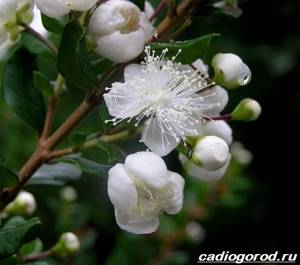
Pictured is Sugar myrtle.
“Sugar” myrtle is grown only at home. The plant is from Africa and is not found outside its borders. Endemic to the Sahara, it is drought-resistant and quite miniature. In nature, the tree grows up to 2 meters.
For comparison, the “Ordinary” Myrtle stretches 5 meters. At home, “Sugar” varieties are usually 60 cm. At the same time, the tree has large leaves. Their length is 4-5 centimeters. The greenery is lanceolate in shape.
The leaves of the “Wrinkled” Myrtle also stand out. The price of the plant is high due to the corrugated greenery. In addition, you can adjust the color of the leaves. They are green in the shade and turn red in the sun. The length of the plates is 2-2.5 centimeters.
The problem is the height of the trees of the species. In nature they grow up to 8 meters. In indoor conditions, “Wrinkled” varieties are reduced to only 3, requiring large rooms with high ceilings.
Cultivated species of Myrtle also include “Reverse-cordate”. Its bushes are lush. At the same time, “Reverse-heart-shaped” Myrtle is miniature. In nature, the tree does not reach 2 meters. At home, the plant does not exceed a meter.
The “Reverse Heart” Myrtle displays purple leaves and bright berries. The fruits gradually turn black. Russian flower growers prefer the Liliput variety. This is a compact shrub about 60 centimeters tall.
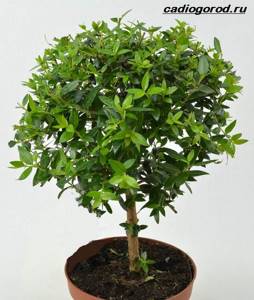
Pictured is myrtle communis
"Liliput" is a hybrid of the "Overseate" and "Wrinkled" species. Therefore, propagating a tree by seeds is risky. Daughter plants do not inherit all the qualities of the parent tree.
These are the characteristics of hybrids. But, they are decorative and resistant to diseases. By the way, about the latter. Let's talk about what ailments Myrtle is susceptible to and how to deal with them.
Diseases and pests of myrtle
The rich smell of Myrtle with disinfecting “notes” repels pests. They approach the bush only at high temperatures, which weaken the plant. This is used by whiteflies, spider mites, scale insects, and mealybugs.
There are chemicals against them. They are sold in flower shops. There are complex remedies for 4 pests at once. Of the folk mixtures, a solution of laundry soap is universal.
But, after processing, they are recommended to shed the flower generously and cover it with film. In hot and humid conditions, spider mites, for example, die. However, the size of Myrtle does not allow it to be placed under a plastic cap.
Diseases of Myrtle include yellowing of leaves and their curling. The problem is excessive lighting. High temperatures, as mentioned, provoke the release of greenery. The same thing happens in drought conditions.
Experienced flower growers shorten the shoots by half. Already in the 2nd week, new leaves will appear and, at the same time, the old ones will not fall off. Of course, the tree also needs to be watered.
People with a sensitive sense of smell need to be afraid not so much of the diseases of the hero of the article, but of their own. The rich aroma of Myrtle can cause headaches and irritate. It's one thing to inhale incense for a couple of hours in church.
Another question is to be near Myrtle all the time. Before starting a tree, it is advised to buy its essential oil and evaporate it from an aroma lamp for several days. If the aroma does not irritate you, you can buy a live bush.
Home care
This is not to say that myrtle will not require any attention from the gardener. No, he has a number of requirements. But if you follow a number of recommendations, even a beginner can cope with its cultivation .
Lighting
This is a light-loving plant, but sunlight can cause burns on the leaves. It is best to place a pot of myrtle on east or west windows .
Windows oriented to the north are an unfavorable option; the foliage will be faded and inexpressive.
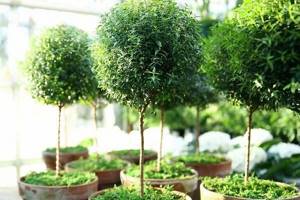
Temperature
The optimal temperature for the comfortable existence of a bush is considered to be from 18 to 20 ° C. In summer you can put it on a glassed-in loggia.
Watering
Bushes prefer well-moistened soils without stagnant moisture . You should not allow the soil in the pot to dry out completely - the myrtle may shed its buds if it is about to bloom, or its foliage.
Air humidity
The plant needs to be sprayed regularly. especially needs additional moisture in spring and autumn , during periods of greatest activity. During cold wintering there is no need to spray the bush.

Fertilizers
The choice of fertilizers is dictated by the desired result. If flowering is important, you should choose fertilizers rich in phosphates. If you want to have a miniature evergreen shrub, stop at nitrogen fertilizers.
In general, any complex supplements are suitable for the good health of myrtle .
Trimming
The procedure will give the crown of the plant the desired shape:
- If you don’t shape the plant at all, it will grow into a pyramidal tree about a meter in height.
- Cut off the top and it will grow into a bush.
- Trimming the side shoots will create a dense crown, which can be shaped into a ball if desired.
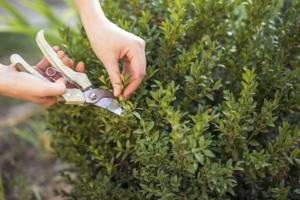
Be careful: if you trim and pinch the plant too often, the number of flowers will decrease . Molding begins a year and a half after purchase.
Attention! You should not work aggressively with freshly purchased myrtle - this can lead to the death of the bush.
Transfer
An adult plant is replanted once every 3–4 years , choosing a new larger pot. If we are talking about transplanting a young myrtle, then it is moved to a larger pot every year.
Rest period
It falls during winter time. At this time, all vital functions of the plant seem to freeze. Myrtle does not shed its leaves (if you don’t get carried away with watering and spraying, which is generally better to stop).
It is ideal to give your pet a cold winter, but if this is not possible, it is enough just not to disturb the bush, not to trim it and not to feed it.
View this post on Instagram
Posted by Ugoloktswetowoda (@ugoloktswetowoda) Apr 17, 2021 at 2:54 PDT
Preparing for winter
At the end of autumn, myrtle begins to be watered less. Ideally, it should be moved to a room with an air temperature of about 12 ° C without drafts and direct sunlight . You should not apply fertilizers - this will prevent the plant from preparing for the dormant period.
Interesting! Myrtle does not shed its leaves. Although all its life processes freeze, the bush remains green.
Caring for myrtle
Myrtle is a flower that is quite simple to care for at home, but will require diligence and accuracy.
This light-loving plant should be placed on the windowsill. In winter, it is advisable to turn on the phytolamp so that the tree receives enough light. It is important that the lighting is diffused, because direct sunlight is dangerous.
The temperature in the room should not be lower than 20-25 °C in summer and 10-12 °C in winter. The tree cannot be overwintered in a warm place (above +15 °C), otherwise it will not bloom. The room must be ventilated regularly. The myrtle tree is perfect for growing on a balcony or in the courtyard of a country house.
Watering mode
In summer, the plant should be watered as soon as the first layer of soil dries. In winter, water a little less often and make sure that the soil does not dry out.
It is best to irrigate with rain or melt water. If they are not available, then, as a last resort, settled tap water may do. Due to lack of moisture, myrtle may dry out. To revive it, you need to put it and the container in water.
Myrtle loves moist air, so it needs to be sprayed regularly. During the summer months, it is advisable to fill the tray with water. Water must not stagnate in the ground.
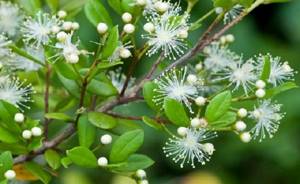
Fills a room or garden with fragrance
Top dressing
The tree needs to be fed once a week for six months (from spring to autumn). There is no need to fertilize in winter. It is best to use complex mineral fertilizers.
Interesting fact! Phosphorus fertilizers stimulate the flowering process, and nitrogen fertilizers stimulate the growth of the stem and crown.
Features of care during flowering and dormancy
The plant begins to bloom in the last days of spring or summer. This period lasts 2 months. When myrtle blooms, caring for it becomes more thorough. The bush needs to be watered and sprayed more often. Don't forget about fertilizing.
During the winter months, the growing season stops. It is important to know how to care for myrtle during the dormant period. It is necessary to place the tree on a glazed balcony: the temperature there should not rise above +10 °C. You will need abundant but diffused lighting.
It is necessary to water once every 7 days, and fertilize once a month.
Preparing for winter
When an adult myrtle fades and drops ripe berries, you need to prepare it for winter. It is necessary to gradually reduce the frequency of watering and spraying, and also move it to a cooler room. Bushes under 3 years old can be left in a warm room.
Crown formation
Myrtle is easy to shape. Depending on the type of pruning, you can get a pyramidal tree, a spherical bush or a miniature bonsai .
Standard
This type is used when the plant has reached the desired size. The lower branches are removed, leaving two or three of the largest ones, and a crown is formed as desired.
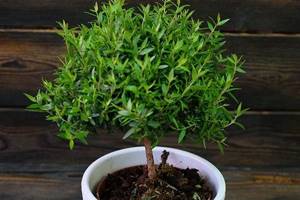
Round
This pruning method is used if the plant has lost its crown for some reason, but there are side branches. In this case, they are directed towards each other along the ring support, secured with twine. The side branches are pruned.

Bonsai
Only slow-growing varieties are suitable for creating bonsai, such as Boethica or Microphylla .
Important! Only plants older than 3 years are suitable for growing miniatures.
How to create a bonsai:
- Choose the right pot: it should be low and wide.
- Any soil is not suitable for growing myrtle bonsai. Choose one that contains more sand so that the plant develops slowly but constantly.
- The bonsai will have to be replanted frequently (annually), cutting the roots to half their length.
- To give the bonsai tree an interesting curved shape, copper wire is wound around the trunk in a spiral. Then the required bend of the trunk is formed and left in this position for up to six months.
- You cannot leave the wire longer than 6 months!
- After removing the wire frame, the myrtle needs 2-3 months to rest, and the procedure is repeated.

Myrtle propagation
Myrtle is propagated using standard methods: seed germination and cuttings.
Growing myrtle from seeds
A labor-intensive process, it is used for propagation by experienced gardeners. The fact is that the seeds do not sprout quickly , and it is difficult to move the sprouts into individual pots without damage.
Propagation of myrtle by cuttings
Cuttings give more stable results and are suitable for quickly producing new plants. The best time to take cuttings is the summer months, when the plant is full of energy and actively developing.
Diseases and pests
Most often, the plant suffers from dry soil, but it happens that the roots begin to rot due to stagnation of moisture in the pot . When root rot develops, it must be transplanted into a new pot, removing all affected roots in the process.
The following pests parasitize myrtle:
- scale insect;
- spider mite;
- mealybug;
- aphid;
- whitefly
If parasites are detected, the bush is treated with insecticides.
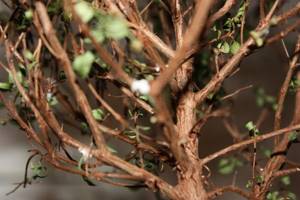
Useful and healing properties of myrtle
Thanks to essential oils, myrtle actively purifies the air in the room, refreshes it, filling it with a pleasant aroma.
It has a bactericidal effect, helps reduce stress levels , and being near the plant helps relieve even severe headaches.
Attention! It is not recommended to place the flowerpot near the bed: the strong smell can cause sleep disturbances.
Myrtle will suit any style and fit into any interior .
Its bright foliage and extraordinary aroma will help create a warm and cozy atmosphere in your home.
Myrtle species
Myrtle has more than 100 varieties . Many varieties of myrtle are grown in botanical gardens and greenhouses. Under natural conditions, the plant reaches 3-5 m. But in cultivation it does not exceed more than 60 cm. Myrtle grows in the USA, Europe, Australia, and Asia.
Swamp Myrtle (calyculata) is an evergreen shrub. It reaches a height of no more than 1 m. It has a spreading crown with straight stems. The branches are covered with miniature scales. The leaves are small, reaching a length of no more than 1-4 cm. The leaf petiole is shortened. The flowers are snow-white, collected in racemes. A special feature of the plant is its adaptability to Russian winters.
Under the snow you can see dry bare branches of myrtle. But if you cut them and put them in a vase, they will turn green. Every spring the plant is reborn again. The growing season lasts from spring until the onset of cold weather. The plant prefers wetlands. Grows well in sphagnum bogs. Commonly called Cassandra. Lives for more than 50 years.
Important! This representative of the flora contains a large amount of poison in its leaves and shoots. Therefore, feeding bog myrtle to livestock is strictly prohibited!
Variegata Myrtle (Variegata) has impeccable variegated leaves. The edges are covered with amber dots and stripes. Requires a lot of sunlight for bright colors. Blooms in good conditions. It has golden-hued stamens and beige-white miniature flowers. Gives off a pleasant aroma. Disinfects the air, removes carbon dioxide.
Can be used to decorate flower arrangements. It grows both indoors and wild. Prefers loose, breathable soil. Responds well to fertilizing. During the growing season it likes frequent spraying. Contains essential oils. Amenable to crown formation. Is a symbol of fertility.
Myrtle Hymen is named after the God of Marriage. Therefore, this plant is sometimes called “the bride’s happiness.” It is considered a symbol of beauty and youth. It is a variation of the common subspecies. It is an evergreen shrub. In the wild it reaches a height of 3-5 m. In indoor conditions it does not exceed 0.8-1 m. It has miniature lanceolate leaves of an emerald hue.

marsh myrtle

Variegated myrtle

Myrtle Hymen
Contains a large amount of essential oil. In spring, miniature flowers form in the axils of the leaves. The flowers are snow-white, reaching 1.5-2 cm in diameter. They have a large number of golden stamens. After flowering, fruits are formed in the form of blue-black berries. The fruits have a strong pleasant aroma.
Bigleaf Myrtle is a variation of the common subspecies. Has an antimicrobial effect. Eliminates pathogenic sticks and bacteria. Helps cope with sore throat and flu. It is used in the prevention and treatment of prostatitis, diseases of the gastrointestinal tract and intestines. Eliminates sinusitis, diphtheria.
It reaches a height of 3-4 m. It has tetrahedral stems. The leaves are very large, opposite, reaching a length of 4-5 cm. They have pointed edges and a glossy surface. The flowers are miniature, snow-white. Formed on elongated stalks. Each flower has five petals. The stamens are symmetrical and golden.
myrtle is an excellent ornamental plant. Can be grown in wild and indoor conditions. It is an excellent decoration for compositions. Loves plenty of sunlight. It has compacted leathery leaves.
The leaves contain a large amount of essential oil. The flowers are snow-white, miniature, very fragrant. Flowering occurs 3 years after planting. The plant blooms in late spring. Forms oval seed pods. A distinctive feature of the plant from other subspecies is its fragrant snow-white fruits. The plant prefers light, breathable soils. Responds well to fertilizing.
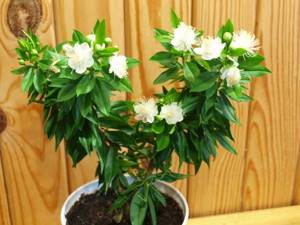
Myrtle macrofolia
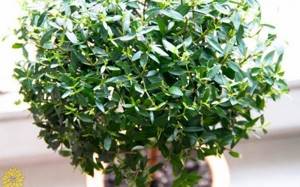
Myrtle Alhambra
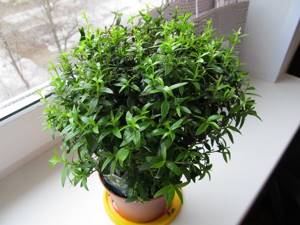
Myrtle of Tarentina
Myrtle Tarentina (Tarentina) is a dwarf form of the common subspecies. It blooms very profusely. It has miniature snow-white flowers in large quantities. Flowers grow in inflorescences. Thanks to essential oils, the plant has a wonderful aroma. It has elongated leaves reaching 1.5 cm.
Leaves with pointed edges and serrated edges. They are formed on short petioles of an emerald hue. The plant has a fast growth rate. It reaches a height of more than 5 m. In room conditions it grows up to 1 m. It prefers systematic watering and water spraying from a spray bottle. Grows well in breathable soils. Loves plenty of sunlight.
Myrtle Communis (communis) is a small evergreen tree, reaching a height of 3-5 m. It has single elongated leaves. The flowers are snow-white, in large quantities. They grow on short racemes. In common parlance, this representative of the flora is called a dead tree. Refers to ornamental crops.
Lemon Myrtle has a wonderful lemony scent. Grows in the tropics of Australia. Used in cooking. Essential oil, various sauces, dressings, syrups and lemon drinks are made from it. Seasoning and spices are made from dry leaves.
Common Myrtle (communis) grows in oak forests next to thickets of bushes. It reaches a height of no more than 4 m. It has bare, tetrahedral stems. The leaves are opposite, oval, growing in groups of three. The flowers are miniature and very fragrant.
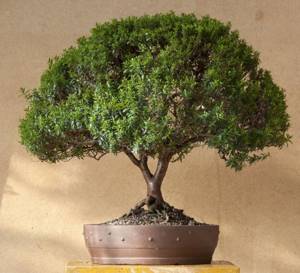
Myrt Communis
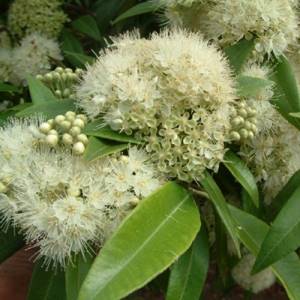
Lemon Myrtle
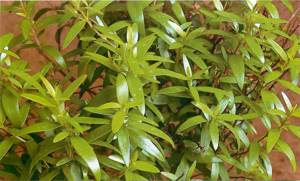
Common myrtle
Myrtle has about 100 different subspecies. It has a fast growth rate. Loves systematic watering and fertilizing. Used for decorating compositions. It grows in botanical gardens and in the wild. Distributed throughout the world.





